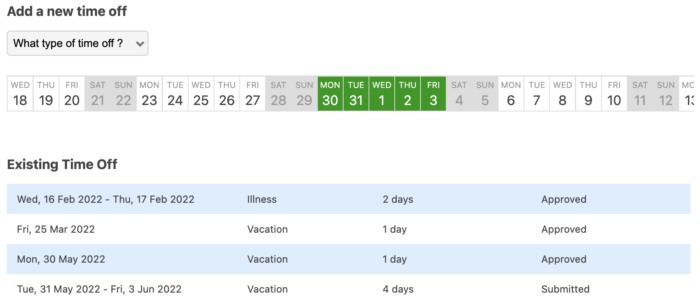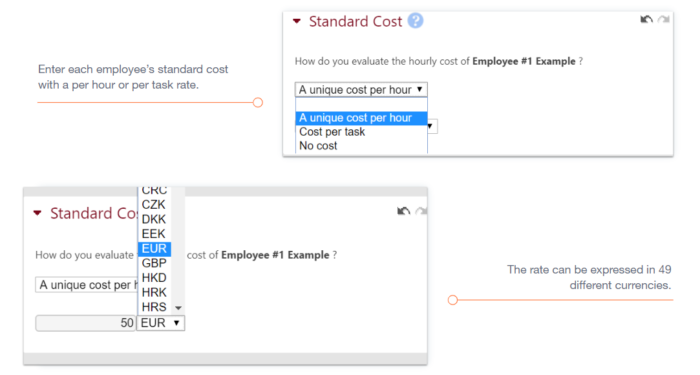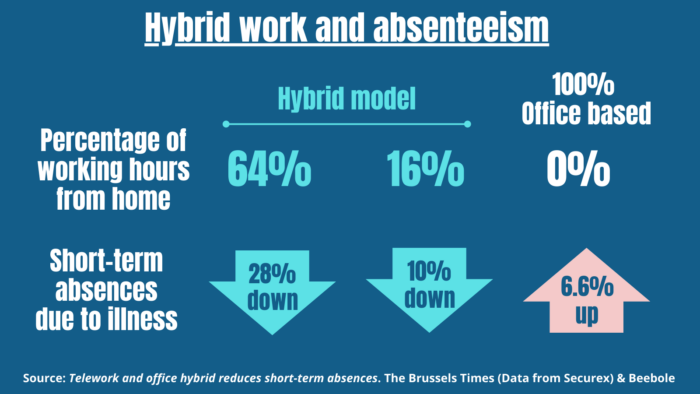How to calculate employee absence rate and why you should do it


Table of Contents
Table of Contents
Absence days in the workplace are prevalent regardless of schedule, sector, or level. It’s just another moving piece of HR and the working world. That’s why it’s essential to understand your employee absence rate and know how to calculate it.
Are you aware of the impact that absence days have in the workplace? Is your company or HR department calculating the employee absence rate correctly? Do you know how to tackle absenteeism effectively? We’re going to dive into some of those questions and provide formulas to help you begin optimizing your business.
Despite the dramatic evidence that exists regarding the large scale costs of absenteeism and presenteeism in the workplace, many companies still misunderstand and neglect these costs. Moreover, this attitude has almost nothing to do with using tools or software. Then, why are so many businesses lost when it comes to absence management?
There are a couple of reasons for this.
First, a lot of companies, especially small ones, don’t understand how to deal with absence days. As explained by HR consultant Lucy Fitzgerald, this “is probably due to competing priorities and a lack of knowledge in dealing with such situations, especially if the business owner knows the employee well.”
Second, many companies simply fear change. Having high levels of absenteeism is an open invitation to changing your work culture. The problem with that is that many companies are not willing to challenge their ways of doing business as usual.
If your company or HR department isn’t doing anything regarding absence management, it’s quite likely one of the two reasons above resonated with you. But two critical questions remain—why should you monitor your absence rates, and how can you do it?
Before we move into the math and numbers of how to calculate your employee absence rate, it is essential to understand the framework surrounding the concept of absence. Let’s start with a straightforward definition.
According to the report “Absence from Work” published by the European Foundation for the Improvement of Living and Working Conditions, absence is non-attendance at work when attendance was scheduled or expected.
Along those lines, absences are those instances that prevent someone from going to work, such as health-related issues, childcare problems, or civic duty. That means that absences don’t include vacation time, personal days, holidays, or labor disputes.
While all this sounds pretty straightforward, the reality is that absences are recorded in different ways across countries. For example, in a country like Norway, the definition of absence doesn’t include caring for family members. While in Poland, this is specifically included. In other words, calculating your absence rate will depend on where you live.
Keeping that in mind, let’s move on to the concept of absence rate, also known as absenteeism rate or absence percentage. Absence rate is the rate of unplanned absence resulting from various causes such as sickness, childcare, and the like. This rate can be calculated for individual employees, for teams, and the organization.
Although the definition of absence changes across countries, we can still use a standard formula to calculate the employee absence rate. The following is the standard measure used by the International Organization for Standardization (ISO):
Absence rate = (number of absent days / number of available workdays in a given period) x 100
As you can see, this formula includes two variables:
For the first variable, you just need to track the absence days of your employees. For the second one, you need to follow your country’s guidelines regarding absence tracking and do your math.
Let’s see an absenteeism rate example to understand this better.
Let’s say that Peter, one of your full-time employees, was absent 10 days in 2019. Since we already know the number of missing days (10), you need to calculate the number of available workdays during that year. Start with the total number of days (365) in a year. Then, subtract the following: weekends (102), public holidays (11), and voluntary days off (20). So, it’ll look something like this:
Number of available workdays: 365 – (102 + 11 + 20) = 232
Now, you can calculate Peter’s absence rate: (10 / 232) x 100 = 4.3%
But, what does Peter’s 4.3% rate say to you? This could be high, as absence greater than 1.5% could be an indication of burnout, conflict at work, or any non-physical cause.
However, if Peter had terrible flu and was forced to stay in bed for two weeks, that doesn’t necessarily fall under absenteeism. It’s also important to note that you shouldn’t be too happy if Peter’s absentee rate were below 1.5%, as that could be a sign of presenteeism. Workplace presenteeism can be even worse for your business.
The most important thing about calculating the employee absenteeism rate is that you can quickly identify patterns and trends that can lead to absenteeism. Identifying those patterns and trends more effectively is possible. You can use additional absenteeism rate formulas to assess absenteeism within your organization better.
Besides the employee absenteeism rate, some additional measurements will help you deal with the frequency and severity of the absences that occur in your company. Let’s take a look at the following methods and examples.
As explained by Fitzgerald, lost time rate “shows the percentage of the total time available that has been lost due to any type of absence during a certain period.” Use the following formula to calculate that percentage:
Lost time rate = (total absence [hours or days] / total hours or days of the period analyzed) x 100
Let’s go back to Peter. Let’s start by saying that Peter was supposed to work 150 hours during January. However, he missed 10 hours of work. If that’s the case, his lost time rate for that month would be the following:
Peter’s lost time rate = (10 / 150) x 100 = 7%
A high lost time rate can indicate a problematic absenteeism rate. Still, it’s essential to keep in mind that this rate is not accurate, as it can be distorted by particular combinations of absence duration and the number of absent employees.
This rate expresses the average number of absence days per worker during a given period. To calculate this rate, use the following formula:
Frequency rate = (total number of periods of absence / total number of employees) x 100
However, if you want to focus on the number of individual employees who have been absent during a specific period, you need to use a slightly different formula:
Individual frequency rate = (total number of employees who were absent / total number of employees) x 100
To illustrate the above, let’s imagine that during a particular period, there were ten periods of absence incurred by five employees out of a total of 30 employees that you have in your staff. If we use the formulas we mentioned before, we will get the following rates:
Frequency rate = (10 / 30) x 100 = 33%
Individual frequency rate = (5 / 30) x 100 = 17%
With severity rate, you can find out the average length of time lost per absence. If this rate is high, it may be a warning sign of absenteeism. Apply the following formula to calculate your employees’ severity rate:
Severity rate = (total number of days absent during a period / total number of times missing during that period) x 100
Measuring the frequency and severity rates within your organization has its perks. You will be in a much better position to identify trends that may lead to absenteeism. “High frequency and severity rates indicate that the employee is absent more frequently and for longer durations, each time resulting in high absenteeism even in absolute terms,” argues an article posted on EconomicsDiscussion.net.
Finally, it is worth mentioning the Bradford factor score, a useful metric used by HR departments to identify recurring short-term absences, which are usually considered more disruptive for business than long-term absences. Let’s see how to calculate the Bradford factor score:
Bradford factor score = (number of occasions of absence)² x total number of days of absence
Keep in mind that the Bradford factor score is calculated annually. Let’s take a look at one quick example so you can see how useful this score is in terms of monitoring short-term absences.
Let’s say that Peter took one absence and was absent for ten days. His Bradford score would be the following: (1)² x 10 = 10.
On the other hand, John took five absences and was absent ten days (meaning that each absence lasted about two days). His Bradford score would be the following: (5)² x 10 = 250.
As you can see, both Peter and John were absent for the same number of days. However, John’s score offers an indication that his short-term absences are recurring because the higher the score, the more frequent the absences are.
John’s score could also be a sign that he is struggling in the current job environment. A secure manager would pinpoint this as a red flag and find an opportunity to address this potential issue.
Before you can dive into calculating your employees’ absence rate, it’s important to have a secure system to accurately and efficiently track absence days. With Beebole, for instance, that’s easier than ever. Thanks to the flexibility of the “Time off” module, employees can simply track their time by selecting the following three variables:
Once they have selected all of the above, employees can see their existing time off with detailed information about the reasons behind the absences, the amount of time involved, and the status of the requested time off (draft, submitted, approved):

Analyzing your employees’ absenteeism rate is just the beginning of the powerful insight Beebole can provide. Using the standard cost settings you can also include the actual cost of your employees, allowing for advanced reporting on profitability, ROI, productivity, and much more.

Calculating employee absenteeism and assessing absences using the formulas highlighted is key. It should be part of a process aimed at fixing problems within your organization. Perhaps the most important thing about these formulas is that you can use them as a point of reference to compare absences, patterns, and behaviors among your staff, departments, and even your industry. The following are some of the benefits you can obtain when you calculate employee absences:
In a perfect world, your focus should be on preventing employee absenteeism from happening in the first place. But how can you use your absence data to achieve that goal? Fitzgerald suggests setting triggers or stages that allow you to manage absences. For example, “any number of absences that establish a set pattern of absence (e.g., Mondays, Fridays, before or after holidays) will result in an absence review meeting,” says Fitzgerald.
While steps like this can go a long way in terms of managing absences, it’s just one part of a much bigger effort. If you genuinely want to tackle absenteeism in the workplace, you should always be open to making changes within your work culture. Furthermore, it would be wise for you to promote a culture of well-being, one where employees feel both engaged and motivated at work. Taking care of your employee absence rate may be the perfect place to start working towards that goal.
In the last couple of years, we have seen how thousands of companies around the world have adopted a hybrid model to run their businesses. The adoption of this model has been fueled to a large extent by the level of flexibility and better work-life balance that modern employees seek nowadays. In fact, the perils of not offering a hybrid model today are high. “Firms that don’t offer weekly work-from-home days risk losing more than 40% of their employees,” states a survey from Harvard Business Review.
Considering the above, we can easily say that hybrid models are here to stay. But how do you handle absences in a company where people are spending significant time away from the office? Let’s start with some good news first.
According to a survey carried out by the human resources company Securex, “hybrid work routines have been shown to reduce short-term absences.” This was particularly evident for employees who spent most of their time working from home. In fact, short-term absences for employees working from home 64% of their time dropped by 28%. In contrast, there was an increase in the percentage of short-term absences for employees who didn’t have any remote work option.

Adopting a hybrid model that has an important remote ingredient could be quite useful for managing workforce absenteeism. For instance, half of the remote employees interviewed for Indeed’s Remote Work Survey said that working from home helped reduce their sick days. According to the survey, 56% said it reduced their absences overall.
Similarly, 86% of those surveyed for FlexJob’s Work-Life-Relationship survey said a flexible working policy would reduce stress levels. Almost 90% claimed they would be able to take better care of themselves.
Likewise, a survey carried out by the International Data Corporation (IDC) “found that 48% of U.S. respondents [working from home] reported higher productivity, 58% reported reduced absenteeism, and one-third have reduced CRE and facility management costs.”
As we saw before, there is significant evidence of the positive impact that a hybrid model can bring in terms of reducing workforce absenteeism. However, this advantage doesn’t take away the challenges you need to face when managing absences under a hybrid model, especially when it comes to sickness-related absences. So, how to do it?
According to Lexology authors Amy Leech and Jessica Pearson, “the key to effective absence management will be to clearly set out expectations around attendance, and the process which will be followed when an employee falls sick.” In order to do that, managers should take a consistent approach to staff absences and “follow correct company procedure regarding absence reporting and insist employees do the same, regardless of whether the employee was intending to work in the office or remotely,” argue Leech and Pearson.
Along those lines, Stephen Simpson, principal employment law editor at XpertHR, shares the following five tips for those employers that want to improve their sickness absence management under a hybrid working model:
Considering everything mentioned, a hybrid model looks promising in terms of reducing employee absenteeism. From now on, however, companies also need to rethink how they measure sickness absence.
“Without clear sickness tracking tools, how would employers know who’s in self-isolation or off sick with symptoms? More so, how will they know if these employees are safe to return to the workplace without compromising the health of others? The requirement for sickness tracking has become more important than ever,” argues Sabrina Munns, Head of People & Culture at e-days.
Employers and HR departments can measure absences effectively by implementing a cloud-based time tracking system where employees can easily start and stop the timer when needed, whether they’re working from home for the day or back in the office. Likewise, companies need to improve the way they track sickness absences. If they are able to put this together, they will be able to optimize their overall businesses.
–
Learn just how valuable your time tracking data is.
How to Calculate Employee Absence Rate and Why You Should Do It was originally published here, and it has been updated with new information and republished with permission from Toolbox.
Photos: Beebole & Pixabay
In the last years, we have seen a new range of technology trends for CFOs and financial management. There has been so much discussion about cloud technology, artificial intelligence and the changing role of the CFO. There is little doubt that these topics will remain crucial in the financial world. However, the experts who contributed […]
The complete list of finance controller KPIs: Webinar + Formulas + Excel included. By The FP&A Guy, Paul Barnhurst.
For the fifth installment of The CFO Journal we talked to Jennifer Ceran, CFO of the project management giant Smartsheet. She shared insights on investing in operational excellence, going public, and her experience as a female executive. Who is Jennifer Ceran? Where: Smartsheet is an enterprise SaaS platform for managing and automating collaborative work. The […]